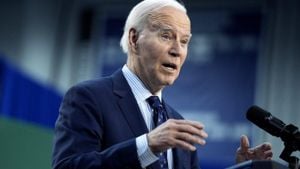Maharashtra is gearing up for the election results set to be unveiled on November 23, following what has been noted as quite the electoral showdown. The excitement is palpable with a 58.25% turnout marking another chapter in the state’s political saga.
The primary players in this contest are the Maha Vikas Aghadi (MVA) and the BJP-led Mahayuti alliance. While most exit polls are singing the praises of Mahayuti, which seems poised for victory, there is still one poll offering hope to the MVA.
Counting of votes is scheduled for Saturday, and anticipation is high as analysts sift through various forecasts. According to the Axis My India exit poll, the Mahayuti alliance is projected to clinch between 178 to 200 seats out of the total 288. This would mark quite the gain as the halfway mark for forming the government stands at 145 seats.
Just to underline the trend, another recent exit poll from Today's Chanakya places the NDA at roughly 175 seats, giving the MVA — which is formed by the Congress, Uddhav Thackeray's Shiv Sena, and Sharad Pawar's Nationalist Congress Party — about 100 seats.
Diving more deeply, the Axis My India exit poll breaks it down regionally. It anticipates the NDA will take 24 seats in Konkan, alongside 30 from Marathwada, 22 from Mumbai, 38 from North Maharashtra, 39 from Vidarbha, and 36 from West Maharashtra. Conversely, it predicts the MVA's potential performance as follows: 13 seats from Konkan, 15 from Marathwada, and so on.
The voting procedures were efficient this time, with electronic voting machine reports reflecting a turnout of 66%, representing a solid uptick from 61.1% seen during the last elections held back in 2019. This enhancement points to concerted efforts from the Election Commission to engage broader segments of the electorate.
Splitting the turnout percentages shows Kolhapur leading the way at 76.63%, closely followed by 75.26% from Gadchiroli, reminding us of the significance of regional priorities. On the flip side, Mumbai lagged behind, registering only 52.07% on the island city and 55.95% on the suburban fringes.
With these quantities at play, the Maharashtra elections represent more than just numbers; they reflect the broader narrative of political strategies and public sentiment.
The focus of these elections stretches beyond the Mahayuti and MVA, as pockets of interest gather around local candidates and issues. Voter sentiment is intertwined with state governance issues like economic management, law and order, and development agendas.
While the Mahayuti is banking on the support reflected by the exit polls, the MVA is working hard to rally its base, countering narratives laid out by their rival parties. Both sides are determining the appeal and effectiveness of their strategies based on these projections.
Moving forward, the dynamics of upcoming legislative decisions and government policies will be observed carefully, along with how the central narratives shaping Maharashtra politics evolve post-election.
Increasingly, participation appears to hinge upon local issues. This trend has been marked by the plight of rural areas facing agricultural challenges, urban centers battling unemployment, and concerns over healthcare and education.
There’s always something brewing beneath the surface. While forecasts and exit polls create a backdrop for the elections, the real test will be how each alliance translates its vision and promises on the ground to resonate with voters effectively.
With just days to go until the results are announced, the stage is set for political theatrics. Whatever the outcome may be, significant outcomes are highly likely to affect not only state governance but the larger political environment across India as parties position themselves for future battles.
The whirlwind of electoral activity promises to keep Maharashtra and its citizens buzzing long after the ballots have been counted and results revealed.



